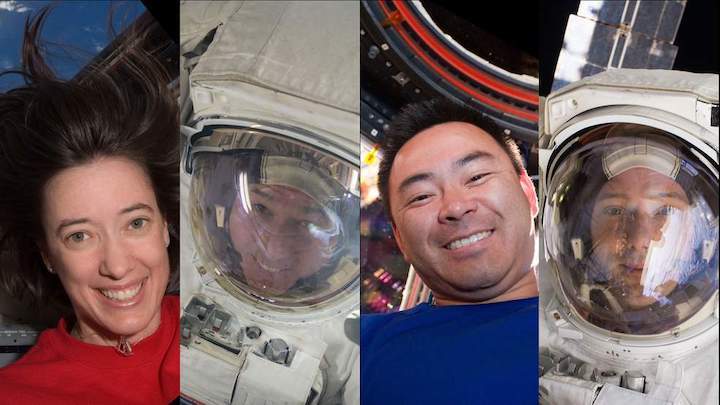KENNEDY SPACE CENTER, Fla. – Two American, one French and a Japanese astronaut will liftoff from Kennedy Space Center in April marking the third human spaceflight for SpaceX’s Crew Dragon spacecraft, NASA announced in a blog post.
The NASA, European Space Agency and Japanese Space Agency (JAXA) crew are slated to launch atop the Falcon 9 rocket from launchpad 39A no earlier than April 20 and travel to the International Space Station, where four other astronauts, who also arrived via SpaceX, will be waiting.
The mission known as Crew-2 will include NASA astronauts Shane Kimbrough and Megan McArthur, JAXA astronaut Akihiko Hoshide and ESA astronaut Thomas Pesquet.
If the liftoff stays on track for late April, NASA astronauts Mike Hopkins, Victor Glover and Shannon Walker, along with JAXA astronaut Soichi Noguchi will be wrapping up their six-month stay on the orbiting laboratory after arriving in another Crew Dragon spacecraft in November.
Additionally there is another Russian Space Agency Soyuz launch slated for spring with three astronauts headed to the ISS, meaning at some point there could be 11 astronauts on station together at the same time.
The arrival of four astronauts will put a strain once again on the ISS sleeping arrangements. The space station is equipped with six sleeping quarters. When Hopkins and the rest of the Crew-1 team arrived, he opted to sleep in the Dragon spacecraft because there were currently seven astronauts on station.
There are several re-supply missions launching early this year that could bring some solutions to address the sleeping space issue but NASA has not released details of a plan for more astronaut bedrooms.
NASA said it’s targeting late April or early May for Crew-1 to return to Earth.
When Crew-2 arrives, they are scheduled for a long-duration stay in space returning sometime in the fall.
SpaceX and NASA are also targeting fall for the launch of the Crew-3 mission with four astronauts: two from NASA, one from ESA and another who has yet to be determined.
Quelle: CLICKORLANDO
----
Update: 4.02.2021
.
SpaceX Crew-2 mission to launch after April 20
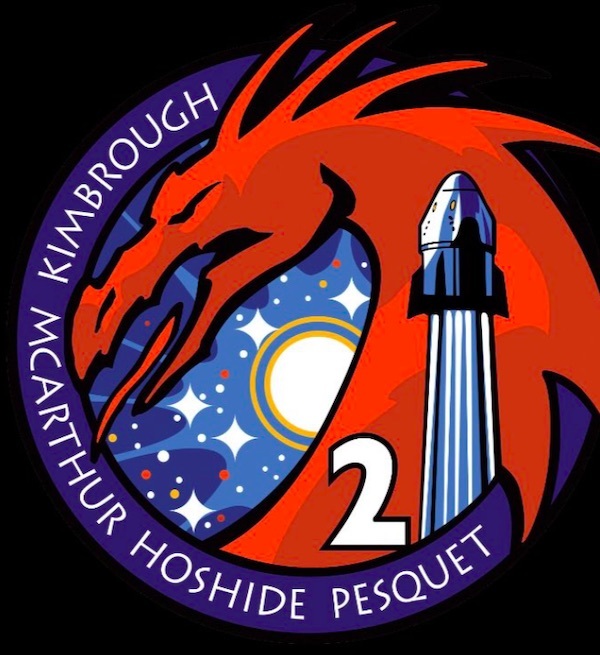
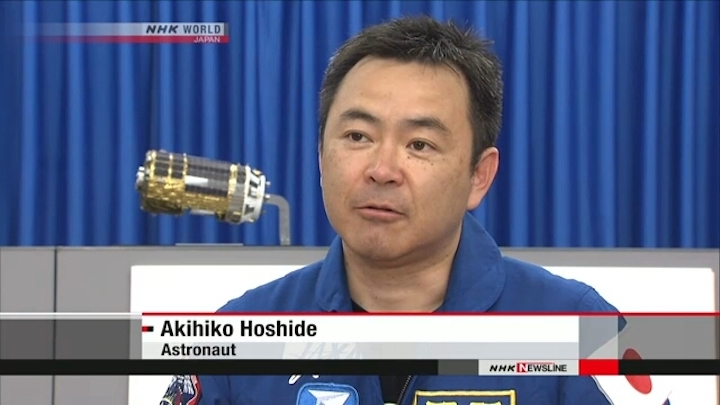
US space agency NASA says it has scheduled the next launch of SpaceX's Crew Dragon capsule after April 20. The spacecraft will carry four astronauts to the International Space Station for a crew member rotation.
The launch will be operated by SpaceX, under contract with NASA, following the first launch last November.
The second mission will carry two NASA astronauts, together with one each from the Japan Aerospace Exploration Agency, JAXA, and European Space Agency, ESA.
The launch will take place at NASA's Kennedy Space Center in Florida. The crew members will stay on the International Space Station till this autumn.
NASA says the SpaceX Crew-2 mission members will overlap with the Crew-1 members who are expected to return in late April or early May.
Japanese astronauts Hoshide Akihiko with Crew-2 and Noguchi Soichi with Crew-1 who flew to the station in November, are expected to spend some time working together on the space station.
Quelle: NHK
----
Update: 23.02.2021
.
NASA to Host Briefings, Interviews for Next Crew Rotation Mission with SpaceX
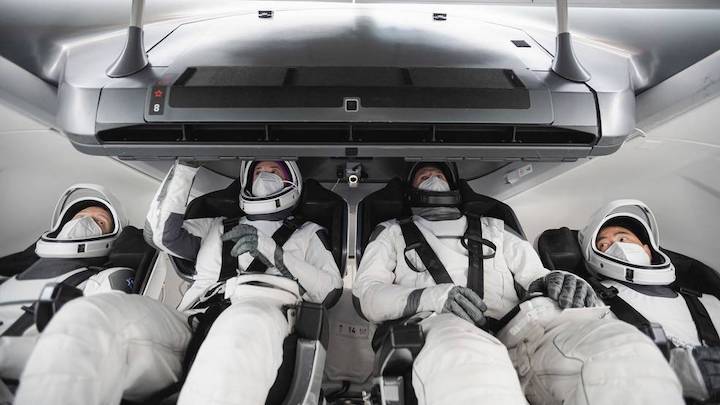
NASA will highlight the second crew rotation flight of a U.S. commercial spacecraft with astronauts to the International Space Station with a pair of news conferences beginning 12:30 p.m. EST Monday, March 1. The briefings, which will take place at the agency’s Johnson Space Center in Houston, will air live on NASA Television, the NASA app, and the agency’s website. The full astronaut crew flying on the mission also will be available for interviews.
NASA’s SpaceX Crew-2 mission will carry astronauts Shane Kimbrough and Megan McArthur of NASA, Akihiko Hoshide of JAXA (Japan Aerospace Exploration Agency), and ESA (European Space Agency) astronaut Thomas Pesquet aboard a Crew Dragon spacecraft atop a Falcon 9 rocket to the space station. The mission is scheduled to launch no earlier than April 20 from Launch Complex 39A at NASA’s Kennedy Space Center in Florida.
All media participation in these news conferences and interviews will be remote; no media will be accommodated at any NASA site. To participate in the briefings by phone or to request an interview with the crew members, reporters must contact Johnson's newsroom at 281-483-5111 or jsccommu@mail.nasa.gov no later than 12 p.m., Thursday, Feb. 25.
Briefings and participants include (all times Eastern):
12:30 p.m. – Crew-2 Mission Overview News Conference with the following participants:
- Kathy Lueders, NASA associate administrator for human exploration and operations, NASA Headquarters
- Steve Stich, manager, Commercial Crew Program, NASA’s Kennedy Space Center
- Joel Montalbano, manager, International Space Station, Johnson
- Benji Reed, senior director, Human Spaceflight Programs, SpaceX
- Junichi Sakai, manager, International Space Station, JAXA
- David Parker, director, Human and Robotic Exploration, ESA
2 p.m. – Crew News Conference with the following participants:
- Astronaut Shane Kimbrough, spacecraft commander, NASA’s SpaceX Crew-2 mission
- Astronaut Megan McArthur, pilot, NASA’s SpaceX Crew-2 mission
- Astronaut Akihiko Hoshide, mission specialist, NASA’s SpaceX Crew-2 mission
- Astronaut Thomas Pesquet, mission specialist, NASA’s SpaceX Crew-2 mission
3:30 p.m. – Round Robin Crew Interviews
- Crew-2 astronauts will be available for a limited number of remote interviews following the news conference.
Shane Kimbrough is commander of the Crew Dragon spacecraft and the Crew-2 mission. Kimbrough is responsible for all phases of flight, from launch to re-entry. He also will serve as an Expedition 65 flight engineer aboard the station. Selected as a NASA astronaut in 2004, Kimbrough first launched aboard space shuttle Endeavour for a visit to the station on the STS-126 mission in 2008, then aboard a Russian Soyuz spacecraft for Expedition 49/50 in 2016. He has spent a total of 189 days in space, and performed six spacewalks. Kimbrough also is a retired U.S. Army colonel and earned a bachelor’s degree in aerospace engineering from the United States Military Academy at West Point, New York, and a master’s degree in operations research from the Georgia Institute of Technology in Atlanta.
Megan McArthur is the pilot of the Crew Dragon spacecraft and second-in-command for the mission. McArthur is responsible for spacecraft systems and performance. She also will be a long-duration space station crew member, making her first trip to the space station. Selected as an astronaut in 2000, McArthur launched on space shuttle Atlantis as a mission specialist on STS-125, the final Hubble Space Telescope servicing mission, in 2009. McArthur operated the shuttle’s robotic arm over the course of the 12 days, 21 hours she spent in space, capturing the telescope and moving crew members during the five spacewalks needed to repair and upgrade it. She holds a bachelor’s degree in aerospace engineering from the University of California, Los Angeles, and a doctorate in oceanography from the University of California, San Diego.
Akihiko Hoshide is a mission specialist for Crew-2. As a mission specialist, he will work closely with the commander and pilot to monitor the vehicle during the dynamic launch and re-entry phases of flight. Once aboard the station, Hoshide will become a flight engineer for Expedition 65. Hoshide joined the National Space Development Agency of Japan (NASDA, currently JAXA) in 1992 and was selected as an astronaut candidate in February 1999. Hoshide is a veteran of two spaceflights. In June 2008, he flew to the International Space Station on the STS-124 mission to deliver the Japanese Experiment Module "Kibo" to the International Space Station. From July to November 2012, he stayed on the space station for 124 days as a flight engineer for the Expedition 32/33 mission. The Crew Dragon will be the third spacecraft that Noguchi has flown to the orbiting laboratory.
Thomas Pesquet will also be a mission specialist for Crew-2, working with the commander and pilot to monitor the vehicle during the dynamic launch and re-entry phases of flight. Pesquet also will become a long-duration crew member aboard the space station. He was selected as an astronaut candidate by ESA in May 2009 and worked as a Eurocom, communicating with astronauts during spaceflights from the mission control center. He previously flew as part of Expeditions 50 and 51, launching aboard a Russian Soyuz spacecraft and spending 196 days in space. His mission also included two spacewalks to maintain the station: one to replace batteries on an electrical channel, and one to fix a cooling leak and service the robotic arm.
Quelle: NASA
----
Update: 2.03.2021
.
NASA, SpaceX to Launch Second Commercial Crew Rotation Mission to International Space Station

NASA and SpaceX are continuing a regular cadence of missions with astronauts launching on an American rocket from American soil to the International Space Station as part of NASA’s Commercial Crew Program. NASA’s SpaceX Crew-2 is the second crew rotation mission with four astronauts flying on a commercial spacecraft, and the first with two international partner astronauts.
NASA’s SpaceX Crew-2 mission will carry astronauts Shane Kimbrough and Megan McArthur of NASA, Akihiko Hoshide of JAXA (Japan Aerospace Exploration Agency), and ESA (European Space Agency) astronaut Thomas Pesquet aboard a Crew Dragon spacecraft launching atop a Falcon 9 rocket on its way to the space station. The mission is scheduled to lift off no earlier than April 20 from Launch Complex 39A at NASA’s Kennedy Space Center in Florida.
The crew is scheduled for a long-duration stay aboard the orbiting laboratory, spending several months conducting science and maintenance before the four astronauts return to Earth in fall 2021.
NASA’s SpaceX Demo-2 test flight completed in 2020 was the final demonstration flight of the Crew Dragon and was followed by NASA completing the certification of the Crew Dragon system ahead of the Crew-1 mission.
All four astronauts were assigned to the Crew-2 mission in July 2020 and began working and training on SpaceX’s next-generation human spacecraft and for their long-duration stay aboard the space station.
Shane Kimbrough is commander of the Crew Dragon spacecraft and the Crew-2 mission. Kimbrough is responsible for all phases of flight, from launch to re-entry. He also will serve as an Expedition 65 flight engineer aboard the station. Selected as a NASA astronaut in 2004, Kimbrough first launched aboard space shuttle Endeavour for a visit to the station on the STS-126 mission in 2008, then aboard a Russian Soyuz spacecraft for his first long-duration mission for Expedition 49/50 in 2016. He has spent a total of 189 days in space and performed six spacewalks. Kimbrough also is a retired U.S. Army colonel and earned a bachelor’s degree in aerospace engineering from the United States Military Academy at West Point, New York, and a master’s degree in operations research from the Georgia Institute of Technology in Atlanta.
Megan McArthur is the pilot of the Crew Dragon spacecraft and second-in-command for the mission. McArthur is responsible for spacecraft systems and performance. She also will be a long-duration space station crew member, making her first trip to the space station. Selected as an astronaut in 2000, McArthur launched on space shuttle Atlantis as a mission specialist on STS-125, the final Hubble Space Telescope servicing mission, in 2009. McArthur operated the shuttle’s robotic arm over the course of the 12 days, 21 hours she spent in space, capturing the telescope and moving crew members during the five spacewalks needed to repair and upgrade it. She holds a bachelor’s degree in aerospace engineering from the University of California, Los Angeles, and a doctorate in oceanography from the University of California, San Diego.
Akihiko Hoshide is a mission specialist for Crew-2. As a mission specialist, he will work closely with the commander and pilot to monitor the spacecraft during the dynamic launch and re-entry phases of flight. Once aboard the station, Hoshide will become a flight engineer for Expedition 65. Hoshide joined the National Space Development Agency of Japan (NASDA, currently JAXA) in 1992 and was selected as an astronaut candidate in February 1999. Hoshide is a veteran of two spaceflights. In June 2008, he flew to the International Space Station on the STS-124 mission to deliver the Japanese Experiment Module "Kibo" to the station. From July to November 2012, he stayed on the space station for 124 days as a flight engineer for the Expedition 32/33 mission. The Crew Dragon will be the third spacecraft that Noguchi has flown to the orbiting laboratory.
Thomas Pesquet will also be a mission specialist for Crew-2, working with the commander and pilot to monitor the spacecraft during the dynamic launch and re-entry phases of flight. Pesquet also will become a long-duration crew member aboard the space station. He was selected as an astronaut candidate by ESA in May 2009 and worked as a Eurocom, communicating with astronauts during spaceflights from the mission control center. He previously flew as part of Expeditions 50 and 51, launching aboard a Russian Soyuz spacecraft and spending 196 days in space. His mission also included two spacewalks to maintain the station: one to replace batteries on an electrical channel, and one to fix a cooling leak and service the robotic arm.
Lifting off from Launch Pad 39A on a Falcon 9 rocket, Crew Dragon will accelerate its four passengers to approximately 17,500 mph and put it on an intercept course with the International Space Station. The Falcon 9 that will be used to launch this mission uses the same booster as NASA’s SpaceX Crew-1, marking the first time a flight-proven booster will be used for a crewed launch.
Once in orbit, the crew and SpaceX mission control will monitor a series of automatic maneuvers that will guide the Crew-2 astronauts to their new home in orbit. After a predetermined time in orbit driven by the launch date, Crew Dragon will be in position to rendezvous and dock with the space station. The spacecraft is designed to dock autonomously with the ability for astronauts aboard the spacecraft to take control and pilot manually, if necessary.
After successfully docking, the astronauts of Crew-2 will be welcomed aboard station by the Expedition 65 crew, including the Crew-1 astronautsstill onboard. The space station’s crew size will again expand to seven people, increasing the amount of crew time available for research.
The Crew Dragon being used for this flight will remain docked to the station for the full length of a long-duration space station expedition, lasting approximately six months. It is the same Crew Dragon capsule, dubbed “Endeavour,” that astronauts Douglas Hurley and Robert Behnken flew to the space station for their historic Demo-2 mission. The Crew-2 astronauts will spend their time aboard the International Space Station conducting new and exciting scientific research in areas, such as medical technology, human health, and materials to benefit life on Earth.
Crew members will test the Butterfly IQ Ultrasound, a portable ultrasound device used in conjunction with a mobile computing device in the space environment. They also will conduct a variety of tissue engineering investigations, ranging from studies of bone, cardiovascular, muscle and liver health. An experiment from retail store Target will study cotton growth in microgravity to help identify more robust cotton varieties that require less water and pesticide use.
During their stay on the orbiting laboratory, astronauts of Crew-2 will see cargo spacecraft including the Northrop Grumman Cygnus and the SpaceX cargo Dragon. They will conduct a series of spacewalks to install new solar arrays, increasing the station’s total available power from 160 kilowatts to up to 215 kilowatts.
At the conclusion of the mission, Crew Dragon will autonomously undock with the four astronauts on board, depart the space station and re-enter the Earth’s atmosphere. After splashdown just off Florida’s coast, a SpaceX recovery vessel will pick up the crew and bring them back to shore to board a plane for return to NASA’s Johnson Space Center in Houston.
The Crew-2 mission continues the efforts of NASA’s Commercial Crew Program to restore and maintain American leadership in human spaceflight. Regular, long-duration commercial crew rotation missions enable NASA to continue the important research and technology investigations taking place onboard the station. Such research benefits people on Earth and lays the groundwork for future exploration of the Moon and Mars starting with the agency’s Artemis program, which will land the first woman and the next man on the lunar surface.
Quelle: NASA
----
Update: 3.04.2021
.
SpaceX and NASA entering final preparations for Crew-2 launch
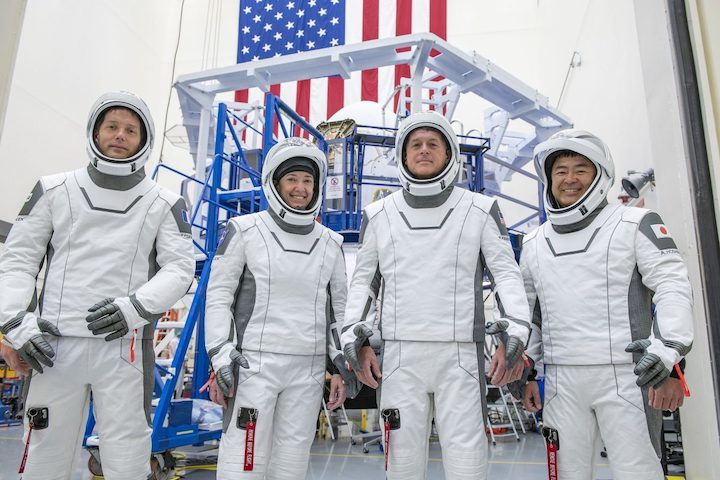
With launch now just a few weeks away, SpaceX and NASA have entered final preparations for the second operational Crew Dragon mission. This will be SpaceX’s second long-duration crew rotation for NASA as a part of the Commercial Crew program.
Crew-2 will launch on a SpaceX Falcon 9 rocket and Crew Dragon spacecraft from historic LC-39A at the Kennedy Space Center on April 22 at 6:11 AM EDT (10:11 UTC). It will also be the first SpaceX crew mission to use flight-proven hardware with Falcon 9 B1061-2 and Crew Dragon Endeavour C206-2.
The crew consists of four veteran astronauts with NASA astronauts Shane Kimbrough and Megan McArthur serving as Spacecraft Commander and Pilot, respectively. They will be joined by JAXA astronaut Akihiko Hoshide and ESA astronaut Thomas Pesquet as Mission Specialists.
This is the first time more then one international partner will fly on a Commercial Crew vehicle and first time more than one international astronaut will fly on a U.S. spacecraft since Koichi Wakata of JAXA and Julie Payette of the Canadian Space Agency (CSA) returned together on shuttle Endeavour’s STS-127 mission in July 2009 – Julie having launched with the mission and Koichi using the Orbiter to return home after four months on the Station.
Like its all veteran crew, Dragon C206 has been to space before. It was named Endeavour by her first crew, Bob Behnken and Doug Hurley when it first supported the SpaceX Demo-2 mission in May 2020, returning the U.S.’s capability to launch crew to the International Space Station domestically.
Endeavour remained docked at the ISS for two-months before returning to Earth in August 2020. It successfully splashed down in the Gulf of Mexico and was recovered by SpaceX’s recovery ship GO Navigator.
Soon after it was taken to Port Canaveral, the capsule began refurbishment in preparation for Crew-2. Inspections were conducted to check nearly all parts of the spacecraft, during which it was found that the heat shield had slightly higher than expected erosion at the four points where the capsule and trunk were bolted together. A fix was implemented before the Crew-1 mission took place with Dragon Resilience.
Additionally, parts of Endeavour‘s PICA-X heat shield were replaced as part of the normal turnaround flow expected. PICA-X is SpaceX’s Proprietary Ablative Material (SPAM).
Additional work was conducted on the craft’s hull, and valves inside that required replacement were swapped out.
Once refurbishments were finished, Endeavour was taken to a SpaceX processing facility at Cape Canaveral Space Force Station where it went through a test campaign of electromagnetic interference, acoustic, and systems verification.

B1061 and Dragon Resilience in the LC-39A HIF prior to Crew-1 – via SpaceX
Soon, SpaceX will mate the capsule to a new unpressurized trunk section before moving the connected duo to the Horizontal Integration Facility (HIF) at LC-39A to be integrated with the Falcon 9 rocket, which includes first stage booster B1061-2.
B1061 is the second Falcon 9 booster to launch crew. It successfully supported the Crew-1 mission in November 2020 and has since been in storage undergoing refurbishments and inspections for the Crew-2 mission. The booster is currently in the LC-39A HIF awaiting Endeavour‘s arrival.
SpaceX is also working to configure LC-39A to support the crew mission, which is no the next flight scheduled depart from the pad.
Since Crew-1, 39A has supported a cargo resupply mission to the Station, a classified mission for the National Reconnaissance Office, and three Starlink launches.
To prepare the pad for crew, the service equipment on the Transporter Erector (T/E) requirements replacement to support Dragon instead of a payload fairing. The team will also verify that the ground support equipment can communicate with Dragon and its crew as well as Range Operations and Mission Control personnel.
Once all modifications are complete, the completed Falcon 9 and Dragon stack will be rolled out to the pad and begin a series of tests. This will culminate with a static fire, where the entire countdown is conducted without crew.

Falcon 9 B1061 sitting on 39A before the launch of Crew-1 – via SpaceX
During static fire, the launch teams will work through a launch-day countdown, including fueling Falcon 9 and test firing all nine of its first stage engines for a few seconds. The crew will not be placed inside the Dragon for the static fire, which is currently set to take place on April 17, five days before launch.
Once the test is complete and all systems are checked out, the launch team and crew will practice launch activities without fueling the rocket. This will include suiting up, being transported to the pad, boarding Dragon, and going through a mock feuling and final countdown to the launch.
Launch and pad teams will practice procedures in case they should need to evacuate the launch pad in an emergency on launch day.
After this testing is complete, SpaceX and NASA will review all of the data at the Launch Readiness Review (LRR) on April 20. The Flight Readiness review, or FRR, will begin on April 15, a week before launch and before the static fire test.
The reviews will involve NASA, SpaceX, JAXA, ESA, and other personnel who will give final approval for the mission’s launch.

Endeavour at the forward port of Harmony on the ISS during Crew Demo-2 – via NASA
On launch day, the countdown will be nearly identical to the SpaceX Demo-2 and Crew-1 missions. The crew will begin suit up at T-4 hours before departing for LC-39A in two modified Tesla Model X vehicles.
At T-45 minutes, the SpaceX launch director will poll the team for a “go” to begin fueling operations. The Crew Access Arm will be retracted to the launch position and Crew Dragon’s SuperDraco abort system will be armed. The abort system will pull Dragon quickly and safely away from the Falcon 9 if an issue were to arise during fueling or launch.
As part of improvements to Dragon with Crew-2, a new modification to Dragon’s abort system has been made. SpaceX has changed the amount of propellant in the system to allow for a longer burn time to push the Dragon farther away during a possible pad abort.
Following a nominal launch, Dragon Endeavour will approach the ISS, performing an automated docking to the Forward port of the Node-2/Harmony module.
In preparation for Crew-2’s docking, Crew-1’s Dragon Resilience will be relocated from the Forward port to the Zenith port of Harmony on April 5. This will be allow a Cargo Dragon spacecraft to dock to the Zenith port once Resilience departs, enabling Canadarm2 to access cargo launched on the CRS-22 mission.
Once docked, Dragon Endeavour and its crew will stay at the ISS for approximately six months. They will join the Expedition 65/66 crew, temporarily increasing the total ISS crew to 11 people, the highest since the Space Shuttle Program.
Once the handover is complete, Crew-1 will depart the ISS on April 28 after five months in orbit, bringing the ISS crew back down to seven.
Meanwhile, after successfully sending Dragon Endeavour on its way to space, Falcon 9 booster B1061-2 will land on one of SpaceX’s Autonomous Spaceport Drone Ships located ~560 km downrange in the Atlantic Ocean.
Once returned to Port Canaveral, the booster will be inspected and refurbished for another flight. Provided recovery is successful, B1061 will join the active booster fleet and begin supporting other missions, bringing the number of active flying boosters to six, alongside B1049, B1051, B1058, B1060, and B1063.
Quelle: NS
----
Update: 11.04.2021
.
Coverage Set for NASA’s SpaceX Crew-2 Briefings, Events, Broadcasts
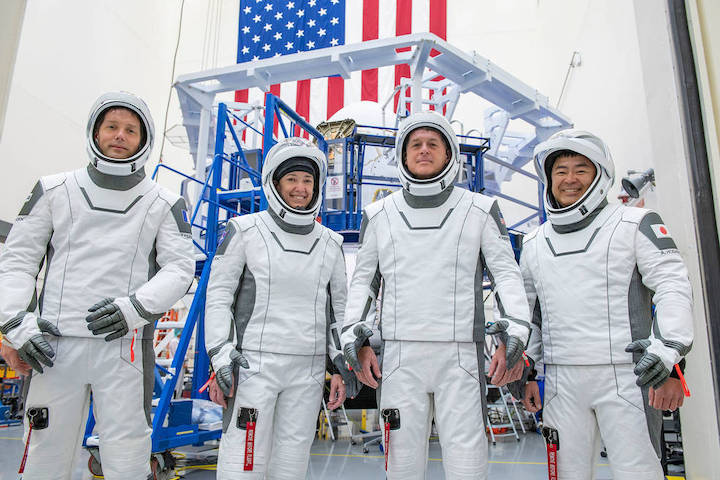
NASA will provide coverage of the upcoming prelaunch and launch activities for the agency’s SpaceX Crew-2 mission with astronauts to the International Space Station. This is the second crew rotation flight of the SpaceX Crew Dragon and the first with two international partners. The flight follows certification by NASA for regular flights to the space station as part of the agency’s Commercial Crew Program.
The launch, on a Falcon 9 rocket, is targeted for 6:11 a.m. EDT Thursday, April 22, from Launch Complex 39A at NASA’s Kennedy Space Center in Florida. The Crew Dragon is scheduled to dock to the space station about 5:30 a.m. Friday, April. 23. Prelaunch activities, launch, and docking will air live on NASA Television, the NASA app, and the agency’s website.
The Crew-2 flight will carry NASA astronauts Shane Kimbrough and Megan McArthur – who will serve as the mission’s spacecraft commander and pilot, respectively – along with JAXA (Japan Aerospace Exploration Agency) astronaut Akihiko Hoshide and ESA (European Space Agency) astronaut Thomas Pesquet, who will serve as mission specialists to the space station for a six-month science mission.
The deadline has passed for media accreditation for in-person coverage of this launch. More information about media accreditation is available by emailing: ksc-media-accreditat@mail.nasa.gov.
All media participation in the following news conferences will be remote except where specifically listed below, and only a limited number of media will be accommodated at Kennedy due to the ongoing coronavirus (COVID-19) pandemic. Please note that the Kennedy Press Site facilities will remain closed throughout these events for the protection of Kennedy employees and journalists, except for a limited number of media who will receive confirmation in writing in the coming days.
Quelle: NASA
----
Update: 17.04.2021
.
NASA SpaceX Crew-2 ‘Go’ for April 22 Launch
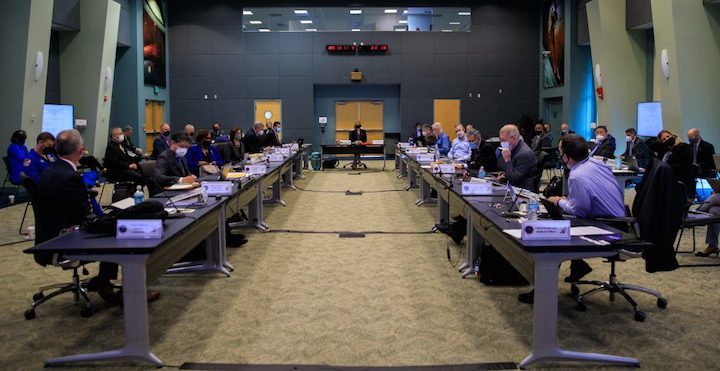

The Flight Readiness Review (FRR) for NASA’s SpaceX Crew-2 mission to the International Space Station has concluded, and teams are proceeding toward a planned liftoff at 6:11 a.m. EDT Thursday, April 22, from Launch Complex 39A at the agency’s Kennedy Space Center in Florida. NASA will hold a media teleconference at approximately 7 p.m. EDT today, April 15, at Kennedy to discuss the outcome of the review. Listen live on NASA’s website.
Participants in the teleconference are:
- Kathy Lueders, associate administrator, Human Exploration and Operations, NASA Headquarters
- Steve Stich, manager, NASA Commercial Crew Program, Kennedy
- Joel Montalbano, manager, International Space Station, NASA’s Johnson Space Center
- Norm Knight, deputy manager, Flight Operations Directorate, Johnson
- Benji Reed, senior director, Human Spaceflight Programs, SpaceX
- Junichi Sakai, manager, International Space Station Program, JAXA
- Frank de Winne, manager, International Space Station Program, ESA
- Randy Repcheck, acting director, Operational Safety, Federal Aviation Administration
Crew-2 mission astronauts Shane Kimbrough and Megan McArthur, along with JAXA (Japan Aerospace Exploration Agency) astronaut Akihiko Hoshide, and ESA (European Space Agency) astronaut Thomas Pesquet, are scheduled to arrive at Kennedy on Friday, April 16, for their flight to the International Space Station. This is the second crew rotation flight of the SpaceX Crew Dragon and the first with two international partners.
+++
Monday, April 19
1 p.m. – Science Media Teleconference to discuss investigations Crew-2 will support during their mission
- David Brady, associate program scientist for the International Space Station Program at Johnson will discuss how the Commercial Crew Program is boosting research aboard the orbiting laboratory.
- ISS U.S. National Laboratory Senior Program Director Dr. Liz Warren will discuss Tissue Engineering, which uses a combination of cells, engineering, and materials to restore, maintain, improve, or replace biological tissues. Scientists will leverage microgravity, which allows cells to grow without scaffolding and in ways that mimic tissues in the human body.
- Dr. Lucie Low from the National Institutes of Health will discuss Tissue Chips, complex bioengineered 3D models that mimic the structure and function of human organ systems. Scientists use tissue chips to test the potential effects of drugs on those tissues and to study diseases.
- ISS Program Scientist for Earth Observations Dr. William Stefanov will discuss Crew Earth Observations. Astronauts have taken more than 3.5 million images of Earth from the space station, contributing to one of the longest-running records of how Earth has changed over time.
- NASA Project Manager for ISS Power Augmentation Bryan Griffith and Boeing’s director for the ISS Structural and Mechanical Development Project Rick Golden will discuss the ISS Roll-out Solar Array compact solar panels that roll open like a yoga mat. In 2017, the basic design underwent testing on the space station to determine its strength and durability, and NASA will deliver the first two of six new arrays that will be delivered this summer to augment the station’s power.
Media may ask questions via phone. For the dial-in number and passcode, please email Stephanie Schierholz no later than 8 a.m. Monday, April. 19, at: stephanie.schierholz@nasa.gov.
Tuesday, April 20
TBD – Prelaunch News Conference at Kennedy (no earlier than one hour after completion of the Launch Readiness Review) with the following participants:
- Steve Stich, manager, Commercial Crew Program, Kennedy
- Joel Montalbano, manager, International Space Station, Johnson
- Kirt Costello, chief scientist, International Space Station Program, Johnson
- Norm Knight, deputy manager, Flight Operations Directorate, Johnson
- Benji Reed, senior director, Human Spaceflight Programs, SpaceX
- Junichi Sakai, manager, International Space Station Program, JAXA
- Frank de Winne, manager, International Space Station Program, ESA
- Brian Cizek, launch weather officer, U.S. Air Force 45th Weather Squadron
Media may ask questions via phone only. For the dial-in number and passcode, please contact the Kennedy newsroom no later than noon Tuesday, April 20, at ksc-newsroom@mail.nasa.gov.
Wednesday, April 21
10 a.m. – Administrator Countdown Clock Briefing with the following participants (limited, previously confirmed in-person media only):
- Steve Jurczyk, acting NASA administrator
- Bob Cabana, Kennedy center director
- Hiroshi Sasaki, vice president and director general, JAXA’s Human Spaceflight Technology Directorate
- Frank de Winne, manager, International Space Station Program, ESA
- NASA astronaut
- NASA astronaut
No teleconference option is available for this event.
Thursday, April 22
2 a.m. – NASA Television launch coverage begins. NASA Television will have continuous coverage, including docking, hatch opening, and welcome ceremony.
7:30 a.m. (approximately) – Postlaunch news conference with the following participants:
- Steve Jurczyk, acting NASA administrator
- Kathy Lueders, associate administrator, Human Exploration and Operations Mission Directorate, NASA Headquarters
- Hiroshi Sasaki, vice president and director general, JAXA’s Human Spaceflight Technology Directorate
- Frank de Winne, manager, International Space Station Program, ESA
- SpaceX representative
Media may ask questions via phone only. For the dial-in number and passcode, please contact the Kennedy newsroom no later than 7 a.m. Thursday, April 22, at: ksc-newsroom@mail.nasa.gov.
Friday, April 23
5:30 a.m. – Docking
7:35 a.m. – Hatch Opening
8:05 a.m. – Welcome Ceremony from the International Space Station with the following participants:
- Kathy Lueders, associate administrator, Human Exploration and Operations Mission Directorate, NASA Headquarters
- Hiroshi Yamakawa, president, JAXA
- Josef Aschbacher, director general, ESA
NASA TV Launch Coverage
NASA TV live coverage will begin at 2 a.m. For NASA TV downlink information, schedules, and links to streaming video, visit:
Audio only of the news conferences and launch coverage will be carried on the NASA “V” circuits, which may be accessed by dialing 321-867-1220, -1240, -1260 or -7135. On launch day, "mission audio," countdown activities without NASA TV launch commentary, will be carried on 321-867-7135.
On launch day, a “clean feed” of the launch without NASA TV commentary will be carried on the NASA TV media channel. Launch also will be available on local amateur VHF radio frequency 146.940 MHz and UHF radio frequency 444.925 MHz, heard within Brevard County on the Space Coast.
Quelle: NASA
----
Update: 18.04.2021
.
Astronauts arrive in Florida for NASA-SpaceX launch: Meet the crew heading to the ISS
Liftoff is scheduled for Thursday.
The four astronauts who are set to lift off next week arrived at the Kennedy Space Center in Florida on Friday for final preparations ahead of the NASA-SpaceX launch.
The Crew-2 mission marks the third time a SpaceX rocket and spacecraft will carry NASA astronauts to the International Space Station and reflects the evolving space-faring landscape as the private sector becomes increasingly involved in the closely watched missions.
Liftoff of the Falcon 9 rocket and Crew Dragon spacecraft is currently scheduled for 6:11 a.m. ET on Thursday from the historic Launch Complex 39A at the Kennedy Space Center. The Crew Dragon is set to dock at the International Space Station at about 5:30 a.m ET on Friday.
During a news conference Friday afternoon, Kennedy Space Center director Bob Cabana told reporters that the Crew Dragon spacecraft being used in Thursday's launch is the same one that sent and returned astronauts Bob Behnken and Doug Hurley during the first-ever manned NASA-SpaceX mission last May.
In addition, the Falcon 9 rocket is the same one that sent the Crew-1 astronauts to the ISS last November.
"Reuse is really important," Steve Jurczyk, NASA's acting administrator, added at Friday's news conference. He also noted that while it's the third crewed commercial spaceflight, "there's a whole lot of firsts with this mission."
"It's the first commercial mission flying two of our international partners to the station and returning them home," Jurczyk said. "It's the first time two commercial crew spacecrafts will be docked to the station."
NASA announced Thursday evening that the mission's Flight Readiness Review had concluded, and they are a "go" for launch Thursday.
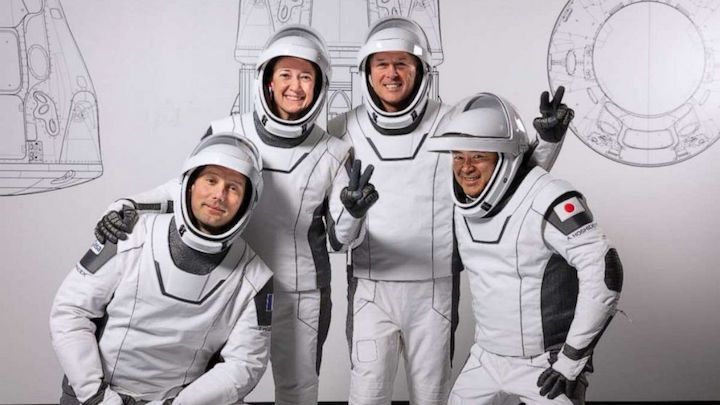
The diverse crew is comprised of two NASA astronauts, one European Space Agency astronaut and one Japan Aerospace Exploration Agency astronaut, who are set to spend six months on the ISS.
Here is what to know about each of the astronauts on the historic mission.
NASA's Shane Kimbrough
Kimbrough, the mission’s commander, is an Army veteran who first went to space in 2008.
The Texas native has logged 189 days in space, and first joined NASA as a flight simulation engineer in 2000. He was selected to be an astronaut in 2004.
Kimbrough, 53, has three children with his wife, Robbie Lynn. His NASA bio says he enjoys baseball, golf, weightlifting and running.
NASA's Megan McArthur
McArthur, 49, is the mission’s pilot -- and is married to fellow astronaut Bob Behnken, who was part of the two-person crew that launched the first-ever NASA-SpaceX flight last May.
She was selected as an astronaut in 2000, and was aboard the final space shuttle mission to the Hubble Space Telescope in 2009. She has spent 13 days in space.
Behnken said in an interview last August that as his wife prepares for her mission, his focus is on "supporting her just as she did me" and caring for their young son.
"It’s definitely her turn to focus on getting her mission accomplished while I take care of the things that need to be taken care of for our home life," Behnken said.
McArthur quipped in a video released by NASA about the crew that the thing she is most looking forward to while living on the ISS is "karaoke night."
JAXA's Akihiko "Aki" Hoshide
Hoshide, a mission specialist, is a native of Tokyo, and went on his first spaceflight in 2008.
After graduating from university in Tokyo, he got a master's degree from the University of Houston, Cullen College of Engineering in Texas.
In 2012, he spent 124 days on the ISS.
The 52-year-old said he is most looking forward to "spending some precious time with each other" while at the space station.
Kimbrough, the mission's commander, quipped that Hoshide had the worst poker face out of the entire crew.
ESA's Thomas Pesquet
Pesquet, who is from France, is the first ESA astronaut to join a NASA-SpaceX mission.
He was selected to become an ESA astronaut in May 2009, and went on his first spaceflight in 2016. He spent six months on the ISS during his first mission.
The 43-year-old has a black belt in judo and also plays the saxophone.
When asked about one thing he was better at than the rest of his crew mates, Pesquet quipped, "French."

